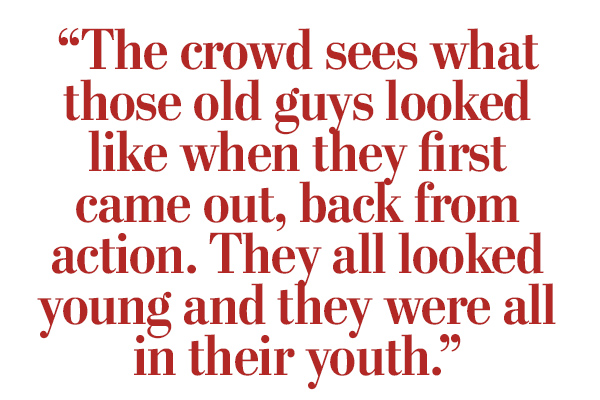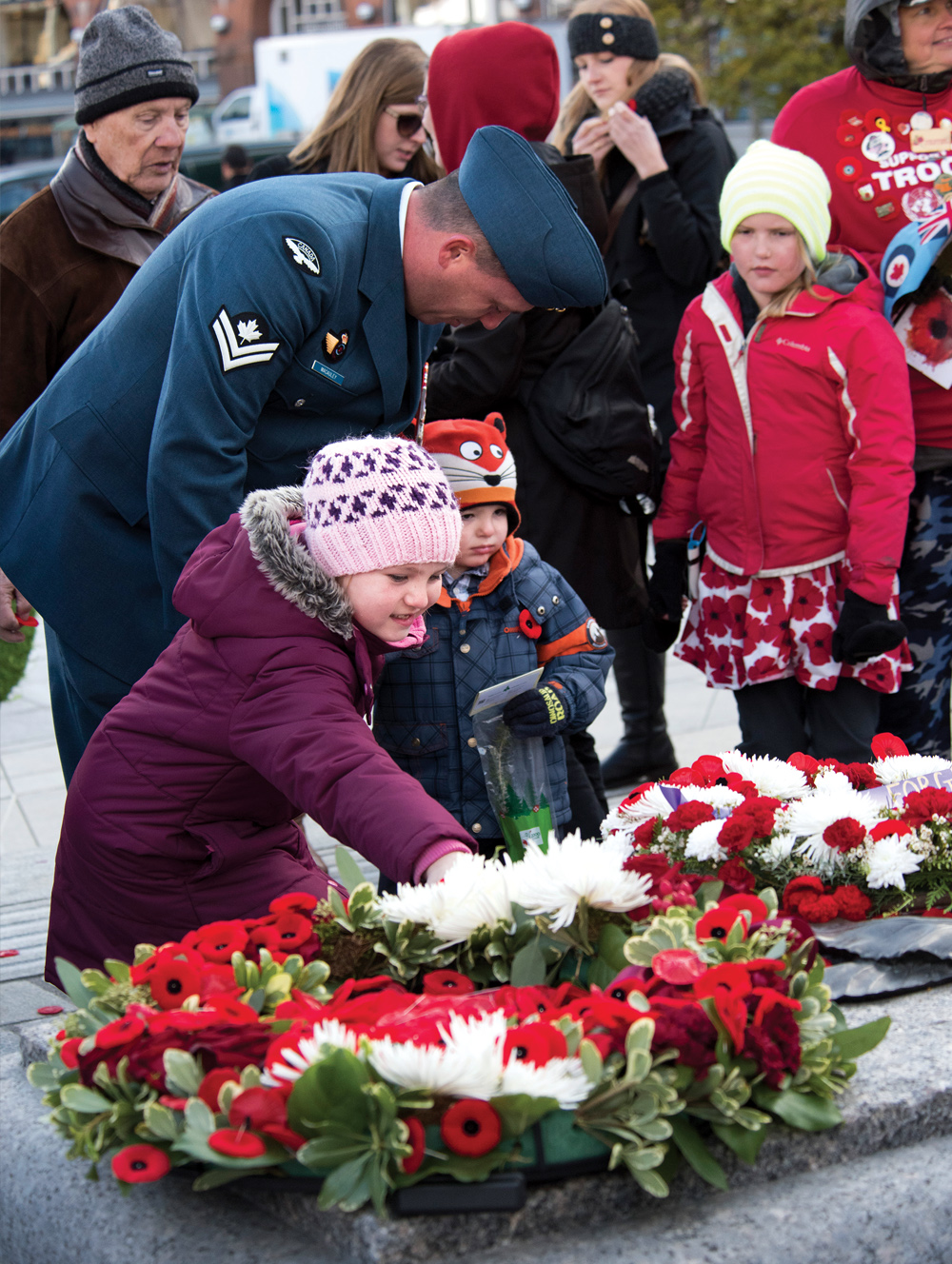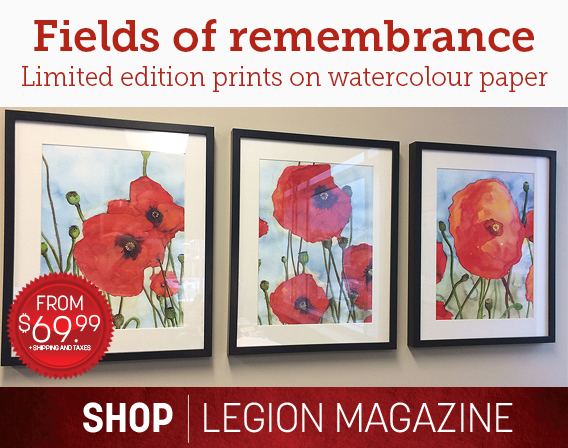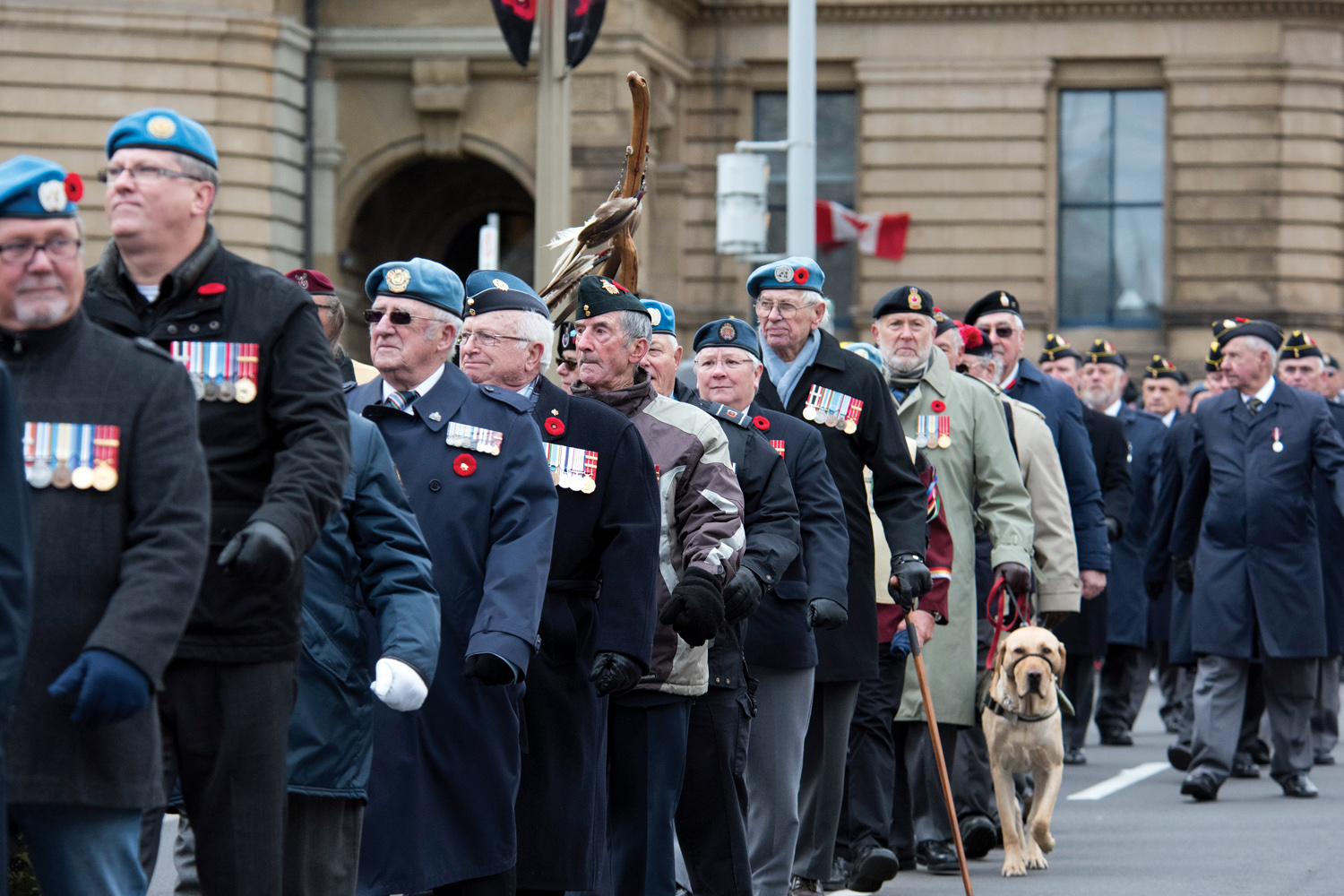
Dwindling numbers of older veterans made the march to the cenotaph in Ottawa for the national Remembrance Day ceremony. [Metropolis Studio]
Four reservists from Halifax
find it worth the drive
For Darrel MacDonald, Nov. 11, 2016, was a long time in coming.
The former corporal in Nova Scotia’s Princess Louise Fusiliers had planned a pilgrimage to Ottawa’s National War Memorial ever since one of his own was killed in Afghanistan nine years ago. Master Corporal Christopher Paul Stannix died along with five other soldiers after their armoured vehicle was taken out by a roadside bomb west of Kandahar on April 8, 2007.
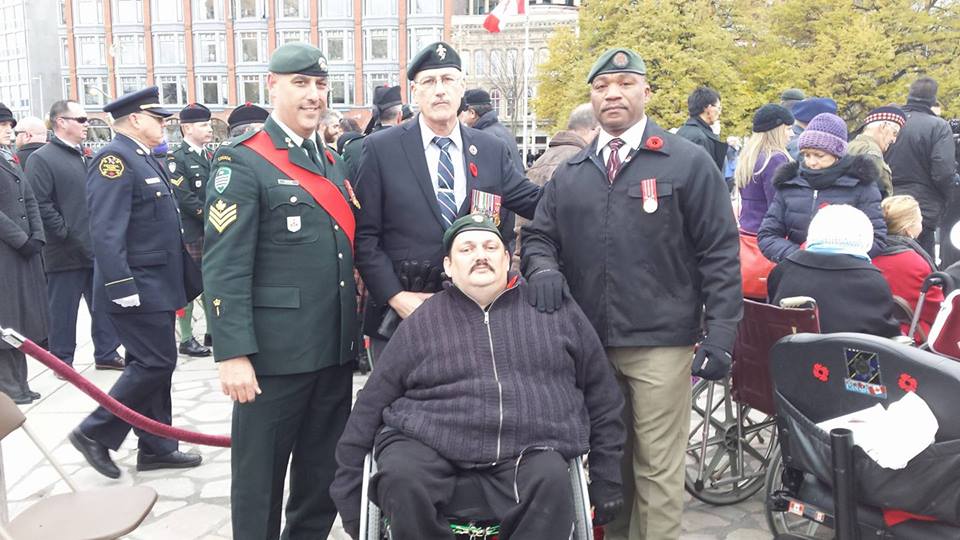
Pictured in front is Cpl. Darrel MacDonald. Back from L-R: Sgt Norm Drake (active 20 yrs +) , Sgt Dave Hutchings ( recently retired, 25 yrs + ) MCpl Blair Skinner ( retired 13 yrs of service). [Darrel MacDonald]
Still headquartered in the old Halifax Armoury, it was the militia unit’s first combat death in decades, and the most Canadian soldiers killed in action in a single day since the Korean War.
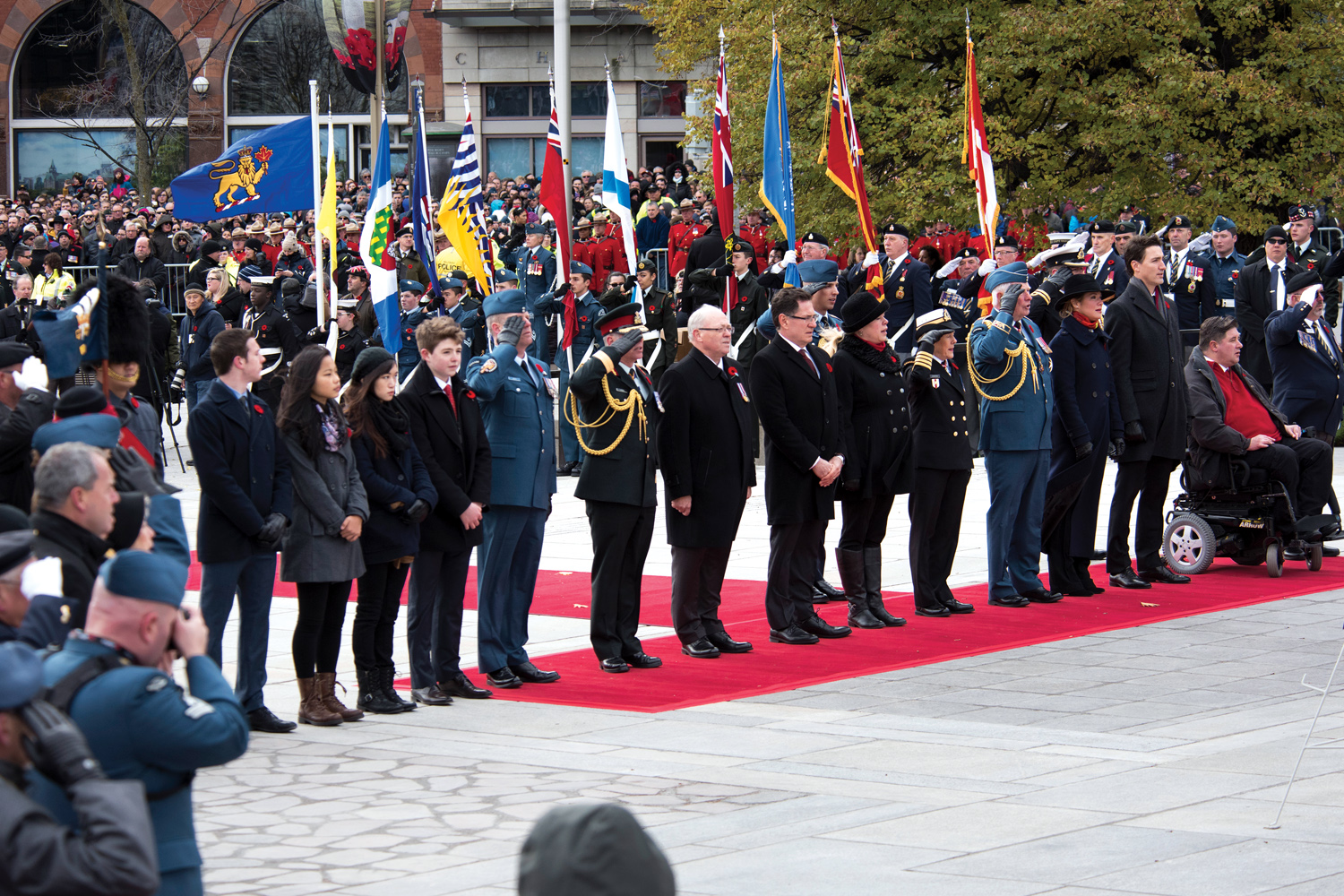
The viceregal party at the National War Memorial in Ottawa on Remembrance Day 2016. [Metropolis Studio]
MacDonald, who has been confined to a wheelchair since a 1998 training accident, resolved to visit the national memorial and pay tribute to his comrade-in-arms and all Canadians killed in the line of duty—more than 117,000 in total.
So just in time for Remembrance Day 2016, MacDonald and four of his reservist mates piled into a vehicle and made the two-day trek to the nation’s capital.
“It’s a trip I’ve always wanted to do,” said MacDonald, who successfully submitted Stannix’s name for a new Halifax-Dartmouth ferry in 2014. “It was worth the drive.”
MacDonald was among tens of thousands who attended the Nov. 11 ceremony at the newly reconditioned granite cenotaph, its bronze soldiers, sailors, airmen and their support elements given new resonance as they slog with grim determination toward the eternal summit.
High winds and bitter cold did not discourage the crowd which lined the streets and surrounded the monument between Parliament Hill and the Chateau Laurier, their numbers surging as they have ever since Canada’s participation in the war on terror refocused attention on the military, its members and their sacrifices.
“It’s a resurgence of Canadian pride and recognition,” declared Jean-Pierre Riendeau, 68, a Metis elder and former member of the Royal 22nd Regiment—the Vandoos.
Riendeau served in Cold War Europe and as a peacekeeper in the Middle East after the Yom Kippur War of 1973. In the last six months of 1974, more than a dozen Canadians were killed and more wounded on peacekeeping duties in Cyprus and the Middle East, nine when Syrian forces shot down a Canadian military aircraft. Riendeau knew many of them.

Canada’s Silver Cross Mother, Colleen Fitzpatrick, and husband Jim in the Peace Tower’s Memorial Chamber with the Book of Remembrance bearing the name of their son, Corporal Darren James Fitzpatrick, killed in Afghanistan on March 6, 2010. [Stephen Thorne]
“People thought it was only the old guys that you saw on Remembrance Day,” he said. “But now I think the crowd sees what those old guys looked like when they first came out, back from action. They all looked young and they were all in their youth. And I think people appreciate that now that they’ve seen people their own age and younger coming back from Afghanistan. They realize the young people are just as committed as the old ones were. It’s good.”
The “old guys,” as Riendeau describes them, are dwindling, their numbers depleted by time. And, as they marched to and from the national memorial this Remembrance Day, their berets atop their heads and medals on their chests, the respectful applause from the huddled masses seemed all the more poignant.
John Newell was among the veterans, an instructor in the British Commonwealth Air Training Plan during the Second World War, now in his 90s, still seeking a formal token of thanks from the country he served.
The program trained more than 131,000 pilots and aircrew between 1940 and 1945.
“We lost a lot of pilots—instructors and students,” Newell said. “And they’re still finding them. Roosevelt called us ‘the aerodrome of democracy.’ Churchill said we constituted one of Canada’s greatest efforts during the war. Yet, Canada never gave us recognition. A flying instructor and their students–hundreds of them—are just as dead flying for Canada as a fighter pilot in England. He gets the recognition; we get nothing.”
Still, the ceremonies meant a lot to him, as they did to all the veterans present.
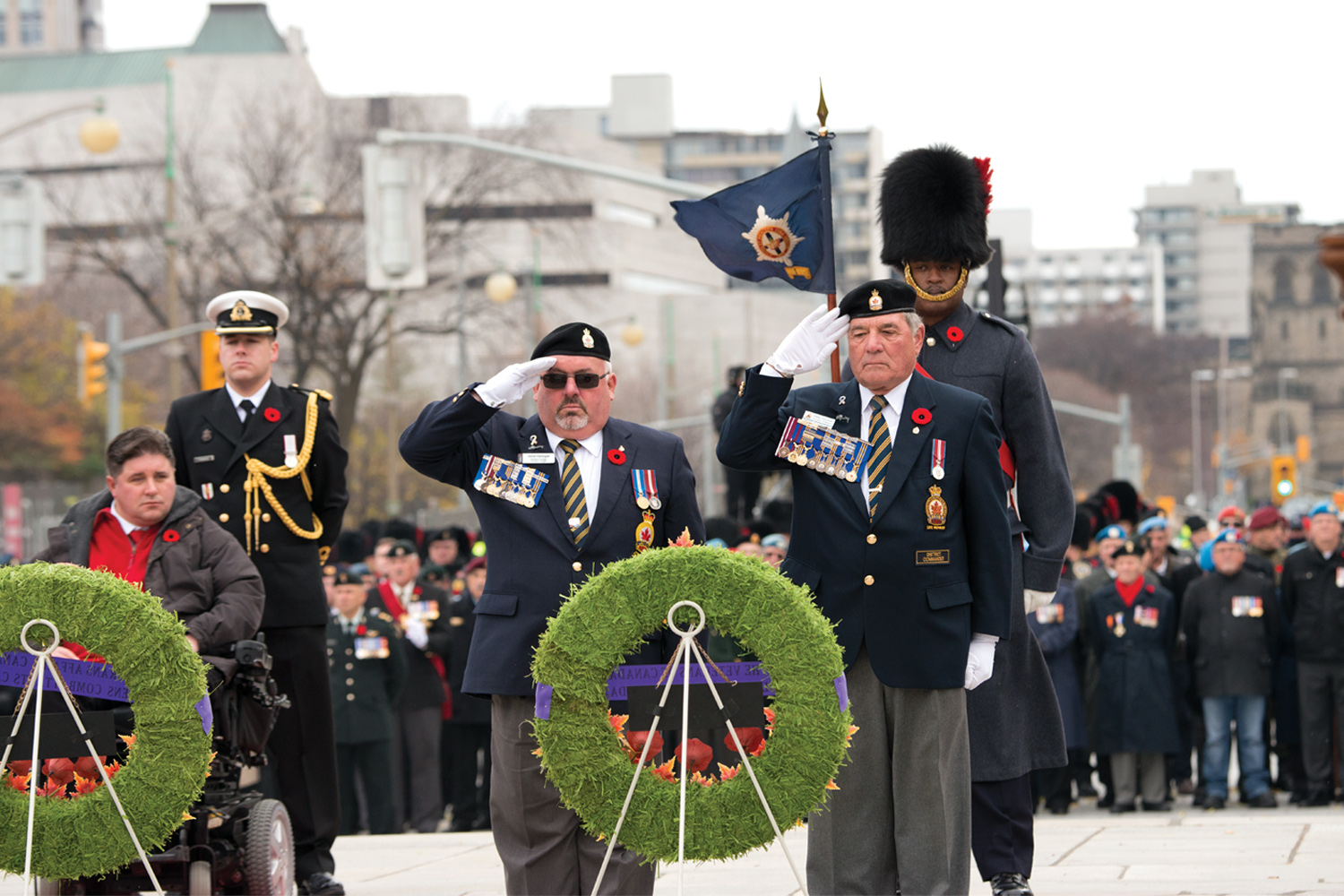
Dominion President David Flannigan (left) and District G Commander Stan Halliday place a wreath at the National War Memorial on behalf of The Royal Canadian Legion. [Metropolis Studio]
With the arrival of the viceregal party, the Central Band of the Canadian Armed Forces, under the direction of Major Dave Shaw, and the Ottawa Children’s Choir, under the direction of Jamie Loback and Allison Prowse, delivered a stirring rendition of O Canada as the Maple Leaf and Union Jack flags snapped in the stiff breeze.
Veterans saluted. Air force Sergeant Fred Paci trumpeted The Last Post. He was followed by the first of 21 guns, fired by the 30th Field Regiment, marking the 11th hour of the 11th day of the 11th month, the moment the First World War ended with the signing of the armistice between Germany and the Allied nations at Compiègne, France, in 1918.
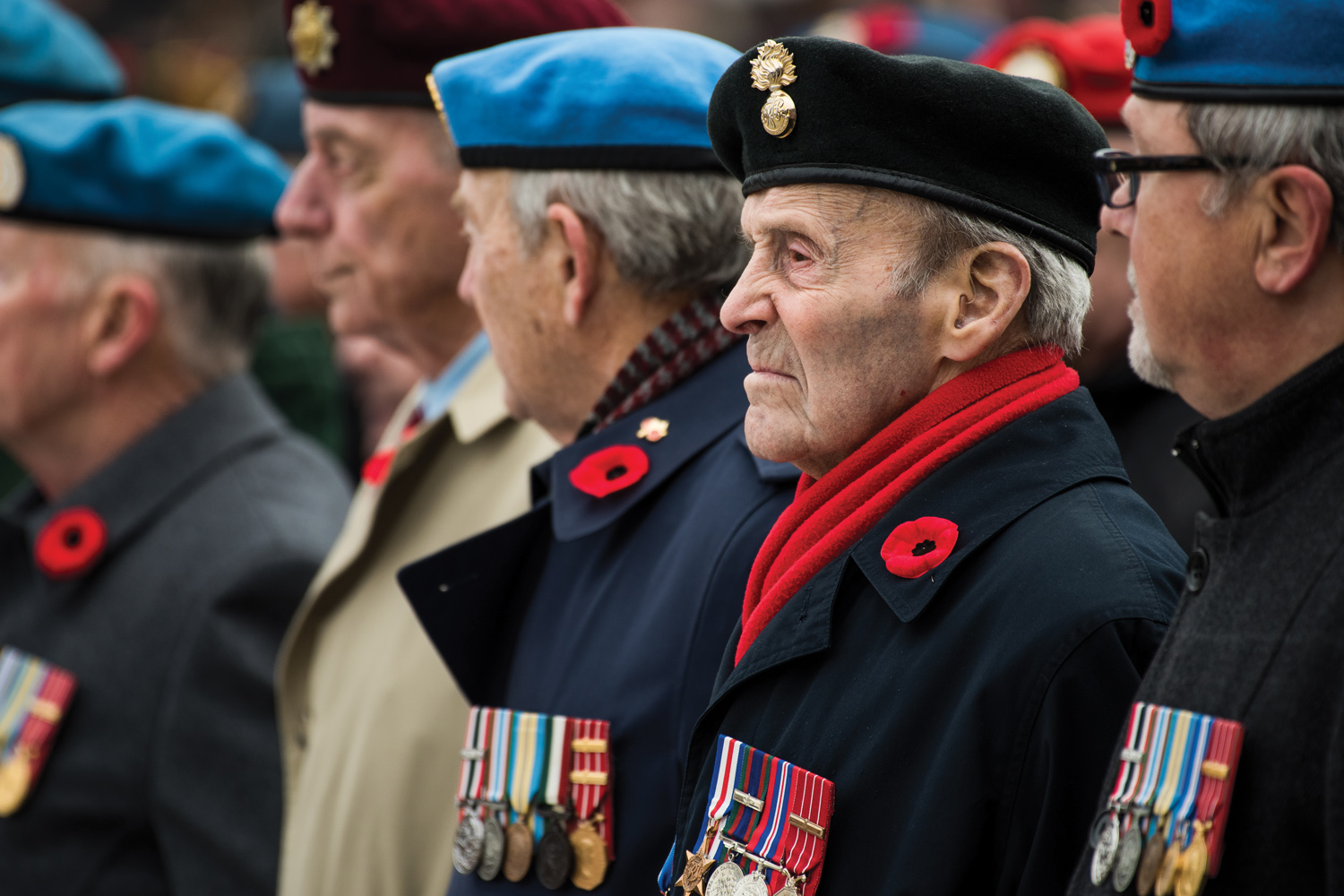
A Second World War veteran wearing a Fusiliers Mont-Royal cap badge bears up against the frigid winds at the National War Memorial. [Richard Lawrence, Courtesy of Dominion Command]
The bells of the Peace Tower tolled 11 times at the outset of two-minutes’ silence. Tears were shed. The bells stopped. The second gun cracked. Sgt. Ken MacKenzie played the piper’s lament, followed by The Rouse, played by Paci. Two CF-18s passed overhead just as he finished, followed by a flight of helicopters.
Dominion President David Flannigan of The Royal Canadian Legion read the Act of Remembrance, a stanza from the poem “For the Fallen” by Laurence Binyon: “They shall grow not old, as we that are left grow old. Age shall not weary them, nor the years condemn. At the going down of the sun and in the morning, we will remember them.”
The guns continued as Brigadier-General Guy Chapdelaine offered words of solace and prayer. “Ocean to ocean,” he said, “we come from different backgrounds, from different religious beliefs and traditions, but we are first and foremost united in our duty to remember.”
As several veterans with PTSD service dogs at their sides looked on, Chapdelaine made a poignant plea for all to remember the battle dead and those scarred not just physically but mentally, referencing the 70 or more Afghanistan veterans who have committed suicide since coming home, as well as all who went before them.
“We remember all those who carry within them the scars of war—on their bodies, in their minds or in their souls,” he said. “We remember all those whose lives were broken by what they saw or did or what they witnessed, knowing that they were powerless to change the course of things.
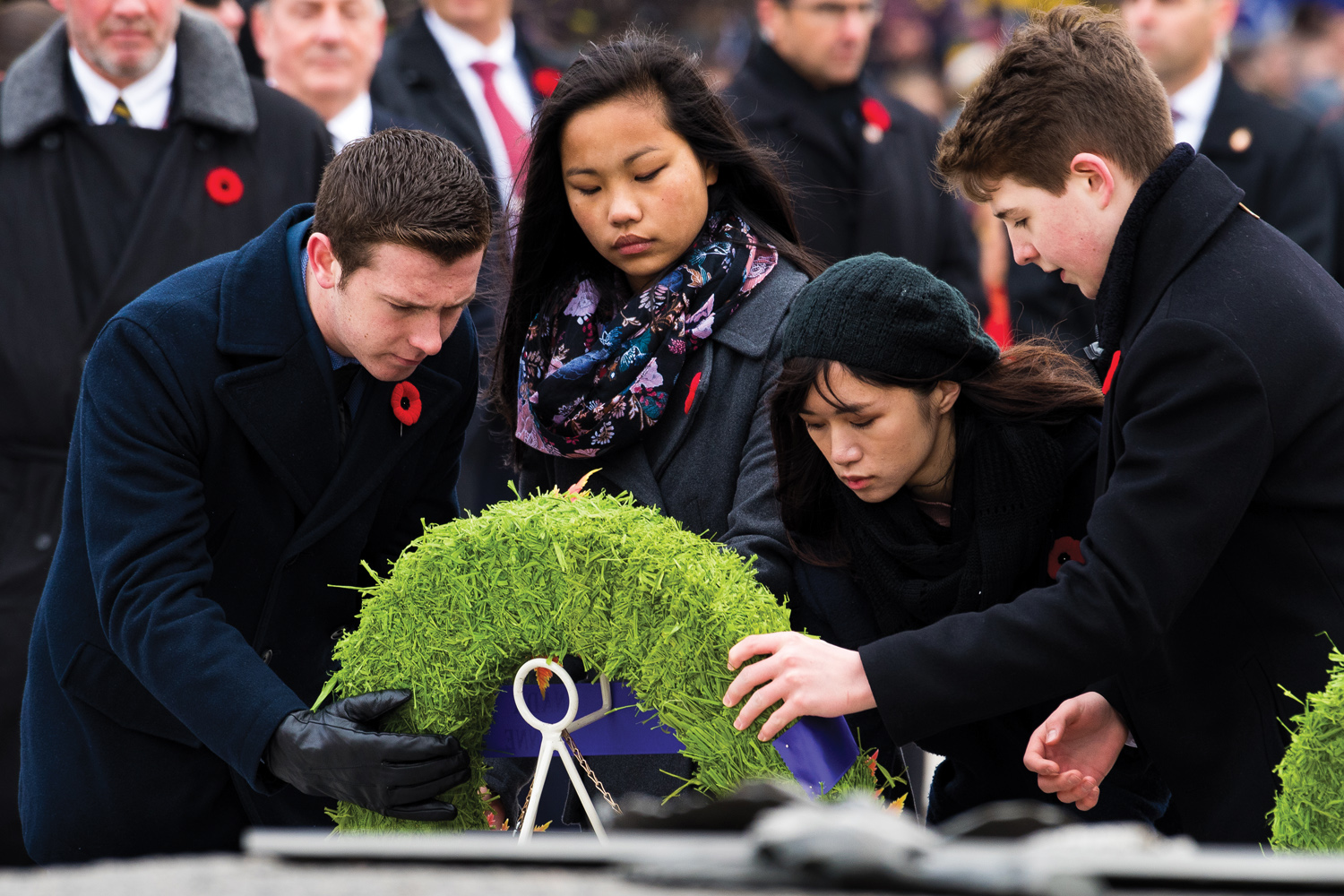
The winners of The Royal Canadian Legion poster and literary contests—Shane Pendergast, Casey O’Neill, Olivia Zeng and Ethan Harry Edstrom—place a wreath on a behalf of the youth of Canada. [Richard Lawrence, Courtesy of Dominion Command]
“We grieve that for some they have felt no other option but to end their lives rather than continue to struggle with the deep pain that they feel. We must help those who suffer in silence.”
As the choir sang In Flanders Fields, the viceregal party began the placing of wreaths, starting with Governor-General David Johnston followed by Silver Cross Mother Colleen Fitzpatrick (for the mothers of Canada); Prime Minister Justin Trudeau and Sophie Gregoire-Trudeau (the Government of Canada); Senate Speaker George Fury (the Parliament of Canada); Veterans Affairs Minister Kent Hehr; General Jonathan Vance, chief of the defence staff and, on behalf of the youth of Canada, the four winners of the Royal Canadian Legion poster and literary contests: Olivia Zeng of Coquitlam, B.C.; Casey O’Neill of Belleisle Creek, N.B.; Shane Pendergast of Mount Stewart, P.E.I. and Ethan Harry Edstrom of Edmonton.
Flannigan placed a wreath on behalf of the Legion before the diplomatic corps and other parties followed with dozens more and crowds laid their poppies on the grave of the unknown soldier.
For Colleen Fitzpatrick, whose son Corporal Darren James Fitzpatrick died after stepping on a mine in Afghanistan six years ago, the emotional ceremony marked the culmination of a whirlwind of interviews and activities surrounding her role.
It all came to a stop for a few minutes on Thursday, however, when the tearful mother entered the white marble Memorial Chamber inside the Peace Tower to view, and touch, the Book of Remembrance in which her son’s name appears.
It was her second time inside the high-ceilinged chamber, with its ornate carving, stained-glass windows and multiple books bearing the names of the dead. The hole in her heart will never heal and seeing his name among the departed doesn’t get any easier, she said.
Walking into the room is “a bit overwhelming,” she said. “It’s very emotional. You can feel the quietness when you enter. And, regardless of how prepared you think you are when you enter, when I saw Darren’s name in the Book of Remembrance, it’s very overwhelming. That’s when you really have to stop and think about the thousands of family members who have been impacted. So, yes, we’re here for Darren but I think of all the loved ones, sons and daughters, who we’ve lost, and all the mothers and fathers who remember every day, not just Remembrance Day. They live with that feeling every day of their lives.”
In his Remembrance Day benediction, punctuated by his “10 bravos,” the honorary chaplain of the Legion, Rabbi Reuven Bulka, said to remember meaningfully is to “express our gratitude not meekly, rather energetically; not generically, rather more specifically.”
“How do we continually say thank you to our veterans? By embracing them. By hugging them. By expressing our appreciation to every veteran we meet in all places and at all times. By teaching our children how much in their debt we always will be. And by exclaiming in unison for them to hear: Bravo!”
Advertisement









